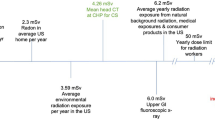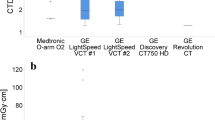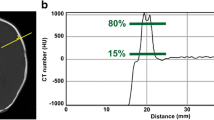Abstract
Background
Children with craniosynostosis may undergo multiple computed tomography (CT) examinations for diagnosis and post-treatment follow-up, resulting in cumulative radiation exposure.
Objective
To reduce the risks associated with radiation exposure, we evaluated the compliance, radiation dose reduction and clinical image quality of a lower-dose CT protocol for pediatric craniosynostosis implemented at our institution.
Materials and methods
The standard of care at our institution was modified to replace pediatric head CT protocols with a lower-dose CT protocol utilizing 100 kV, 5 mAs and iterative reconstruction. Study-ordered, protocol-utilized and radiation-dose indices were collected for studies performed with routine pediatric brain protocols (n=22) and with the lower-dose CT protocol (n=135). Two pediatric neuroradiologists evaluated image quality in a subset (n=50) of the lower-dose CT studies by scoring visualization of cranial structures, confidence of diagnosis and the need for more radiation dose.
Results
During the 30-month period, the lower-dose CT protocol had high compliance, with 2/137 studies performed with routine brain protocols. With the lower-dose CT protocol, volume CT dose index (CTDIvol) was 1.1 mGy for all patients (0–9 years old) and effective dose ranged from 0.06 to 0.22 mSv, comparable to a 4-view skull radiography examination. CTDIvol was reduced by 98% and effective dose was reduced up to 67-fold. Confidence in diagnosing craniosynostosis was high and more radiation dose was considered unnecessary in all studies (n=50) by both radiologists.
Conclusion
Replacing the routine pediatric brain CT protocol with a lower-dose CT craniosynostosis protocol substantially reduced radiation exposure without compromising image quality or diagnostic confidence.










Similar content being viewed by others
References
Governale LS (2015) Craniosynostosis. Pediatr Neurol 53:394–401
Neverauskiene A, Maciusovic M, Burkanas M et al (2018) Image based simulation of the low dose computed tomography images suggests 13 mAs 120 kV suitability for non-syndromic craniosynostosis diagnosis without iterative reconstruction algorithms. Eur J Radiol 105:168–174
Di Rocco F, Arnaud E, Renier D (2009) Evolution in the frequency of nonsyndromic craniosynostosis. J Neurosurg Pediatr 4:21–25
Badve CA, Mallikarjunappa MK, Iyer RS et al (2013) Craniosynostosis: imaging review and primer on computed tomography. Pediatr Radiol 43:728–742
Panchal J, Uttchin V (2003) Management of craniosynostosis. Plast Reconstr Surg 111:2032–2048
Rozovsky K, Udjus K, Wilson N et al (2016) Cranial ultrasound as a first-line imaging examination for craniosynostosis. Pediatrics 137:e20152230
Kuusela L, Hukki A, Brandstack N et al (2018) Use of black-bone MRI in the diagnosis of the patients with posterior plagiocephaly. Childs Nerv Syst 34:1383–1389
Patel KB, Eldeniz C, Skolnick GB et al (2020) 3D pediatric cranial bone imaging using high-resolution MRI for visualizing cranial sutures: a pilot study. J Neurosurg Pediatr 12:1–7
Branson HM, Shroff MM (2011) Craniosynostosis and 3-dimensional computed tomography. Semin Ultrasound CT MR 32:569–577
Ursitti F, Fadda T, Papetti L et al (2011) Evaluation and management of nonsyndromic craniosynostosis. Acta Paediatr 100:1185–1194
National Research Council (2006) Health risks from exposure to low levels of ionizing radiation: BEIR VII phase 2. National Academies Press, Washington, DC
Frush DP, Donnelly LF, Rosen NS (2003) Computed tomography and radiation risks: what pediatric health care providers should know. Pediatrics 112:951–957
Strauss KJ, Goske MJ, Kaste SC et al (2010) Image gently: ten steps you can take to optimize image quality and lower CT dose for pediatric patients. AJR Am J Roentgenol 194:868–873
Pearce MS, Salotti JA, Little MP et al (2012) Radiation exposure from CT scans in childhood and subsequent risk of leukaemia and brain tumours: a retrospective cohort study. Lancet 380:499–505
Mathews JD, Forsythe AV, Brady Z et al (2013) Cancer risk in 680,000 people exposed to computed tomography scans in childhood or adolescence: data linkage study of 11 million Australians. BMJ 346:f2360
Yu L, Liu X, Leng S et al (2009) Radiation dose reduction in computed tomography: techniques and future perspective. Imaging Med 1:65–84
Vazquez JL, Pombar MA, Pumar JM, del Campo VM (2013) Optimised low-dose multidetector CT protocol for children with cranial deformity. Eur Radiol 23:2279–2287
Kalender WA, Buchenau S, Deak P et al (2008) Technical approaches to the optimisation of CT. Phys Med 24:71–79
Dougeni E, Faulkner K, Panayiotakis G (2012) A review of patient dose and optimization methods in adult and paediatric CT scanning. Eur J Radiol 81:e665–e683
Beister M, Kolditz D, Kalender WA (2012) Iterative reconstruction methods in x-ray CT. Phys Med 28:94–108
Lipnharski I, Carranza C, Quails N et al (2016) Optimizing dose reduction in adult head CT protocols while maintaining image quality in postmortem head scans. Med Phys 43:3397–3397
Lipnharski I, Quails N, Carranza C et al (2017) Optimizing dose reduction in pediatric head CT protocols while maintaining image quality in postmortem head scans. Oral presentation at the Young Investigator Clinical Symposium of the American Association of Physicists in Medicine (AAPM) Clinical Meeting, New Orleans, 18 March 2017
Lipnharski I (2017) Measuring organ doses and assessing clinical image quality for the purpose of computed tomography protocol optimization. Dissertation, University of Florida
American Association of Physicists in Medicine (2008) AAPM report no. 96. The measurement, reporting, and management of radiation dose in CT. American Association of Physicists in Medicine, College Park, MD
Jones DG, Shrimpton PC (1991) Survey of CT practice in the UK. Part 3: normalized organ doses calculated using Monte Carlo techniques (NRPB-R250). National Radiological Protection Board, Chilton
Khursheed A, Hillier MC, Shrimpton PC, Wall BF (2002) Influence of patient age on normalized effective doses calculated for CT examinations. Br J Radiol 75:819–830
Russell WP, Russell MR (2020) Anatomy, head and neck, coronal suture. StatPearls Publishing, Treasure Island
Cohen J (1968) Weighted kappa: nominal scale agreement with provision for scaled disagreement or partial credit. Psychol Bull 70:213–220
Brindhaban A, Eze CU (2006) Estimation of radiation dose during diagnostic x-ray examinations of newborn babies and 1-year-old infants. Med Princ Pract 15:260–265
Mazonakis M, Damilakis J, Raissaki M, Gourtsoyiannis N (2004) Radiation dose and cancer risk to children undergoing skull radiography. Ped Radiol 34:624–629
Mettler FA Jr, Huda W, Yoshizumi TT, Mahesh M (2008) Effective doses in radiology and diagnostic nuclear medicine: a catalog. Radiology 248:254–263
Ernst CW, Hustaert TL, Belsack D et al (2016) Dedicated sub 0.1 mSv 3DCT using MBIR in children with suspected craniosynostosis: quality assessment. Eur Radiol 26:892–899
Jaffurs D, Denny A (2009) Diagnostic pediatric computed tomographic scans of the head: actual dosage versus estimated risk. Plast Reconstr Surg 124:1254–1260
Calandrelli R, D’Apolito G, Gaudino S et al (2014) Identification of skull base sutures and craniofacial anomalies in children with craniosynostosis: utility of multidetector CT. Radiol Med 119:694–704
Kaasalainen T, Palmu K, Lampinen A et al (2015) Limiting CT radiation dose in children with craniosynostosis: phantom study using model-based iterative reconstruction. Pediatr Radiol 45:1544–1553
Morton RP, Reynolds RM, Ramakrishna R et al (2013) Low-dose head computed tomography in children: a single institutional experience in pediatric radiation risk reduction. J Neurosurg Pediatr 12:406–410
Montoya JC, Eckel LJ, DeLone DR et al (2017) Low-dose CT for craniosynostosis: preserving diagnostic benefit with substantial radiation dose reduction. AJNR Am J Neuroradiol 38:672–677
Pickhardt PJ, Lubner MG, Kim DH et al (2012) Abdominal CT with model-based iterative reconstruction (MBIR): initial results of a prospective trial comparing ultralow-dose with standard-dose imaging. AJR Am J Roentgenol 199:1266–1274
Katsura M, Matsuda I, Akahane M et al (2012) Model-based iterative reconstruction technique for radiation dose reduction in chest CT: comparison with the adaptive statistical iterative reconstruction technique. Eur Radiol 22:1613–1623
Miéville FA, Berteloot L, Grandjean A et al (2013) Model-based iterative reconstruction in pediatric chest CT: assessment of image quality in a prospective study of children with cystic fibrosis. Pediatr Radiol 43:558–567
Deák Z, Grimm JM, Treitl M (2013) Filtered back projection, adaptive statistical iterative reconstruction, and a model-based iterative reconstruction in abdominal CT: an experimental clinical study. Radiology 266:197–206
Smith EA, Dillman JR, Goodsitt MM et al (2014) Model-based iterative reconstruction: effect on patient radiation dose and image quality in pediatric body CT. Radiology 270:526–534
Gervaise A, Osemont B, Lecocq S et al (2012) CT image quality improvement using adaptive iterative dose reduction with wide-volume acquisition on 320-detector CT. Eur Radiol 22:295–301
Singh S, Kalra MK, Hsieh J et al (2010) Abdominal CT: comparison of adaptive statistical iterative and filtered back projection reconstruction techniques. Radiology 257:373–383
Eley KA, Thomas GPL, Sheerin F et al (2016) The significance of squamosal suture synostosis. J Craniofac Surg 27:1543–1549
Raju NS, Ishwar P, Banerjee R (2017) Role of multislice computed tomography and three-dimensional rendering in the evaluation of maxillofacial injuries. J Oral Maxillofac Radiol 5:67–73
Author information
Authors and Affiliations
Corresponding author
Ethics declarations
Conflicts of interest
None
Additional information
Publisher’s note
Springer Nature remains neutral with regard to jurisdictional claims in published maps and institutional affiliations.
Rights and permissions
About this article
Cite this article
Barreto, I.L., Tuna, I.S., Rajderkar, D.A. et al. Pediatric craniosynostosis computed tomography: an institutional experience in reducing radiation dose while maintaining diagnostic image quality. Pediatr Radiol 52, 85–96 (2022). https://doi.org/10.1007/s00247-021-05205-6
Received:
Revised:
Accepted:
Published:
Issue Date:
DOI: https://doi.org/10.1007/s00247-021-05205-6




